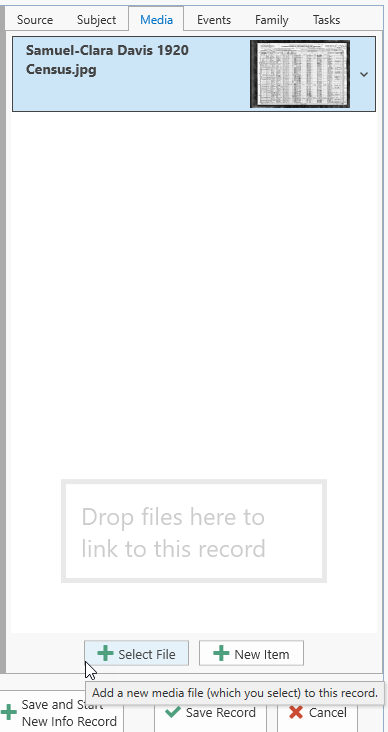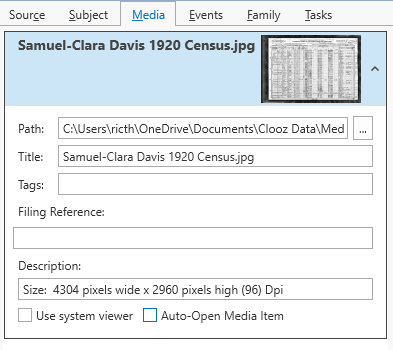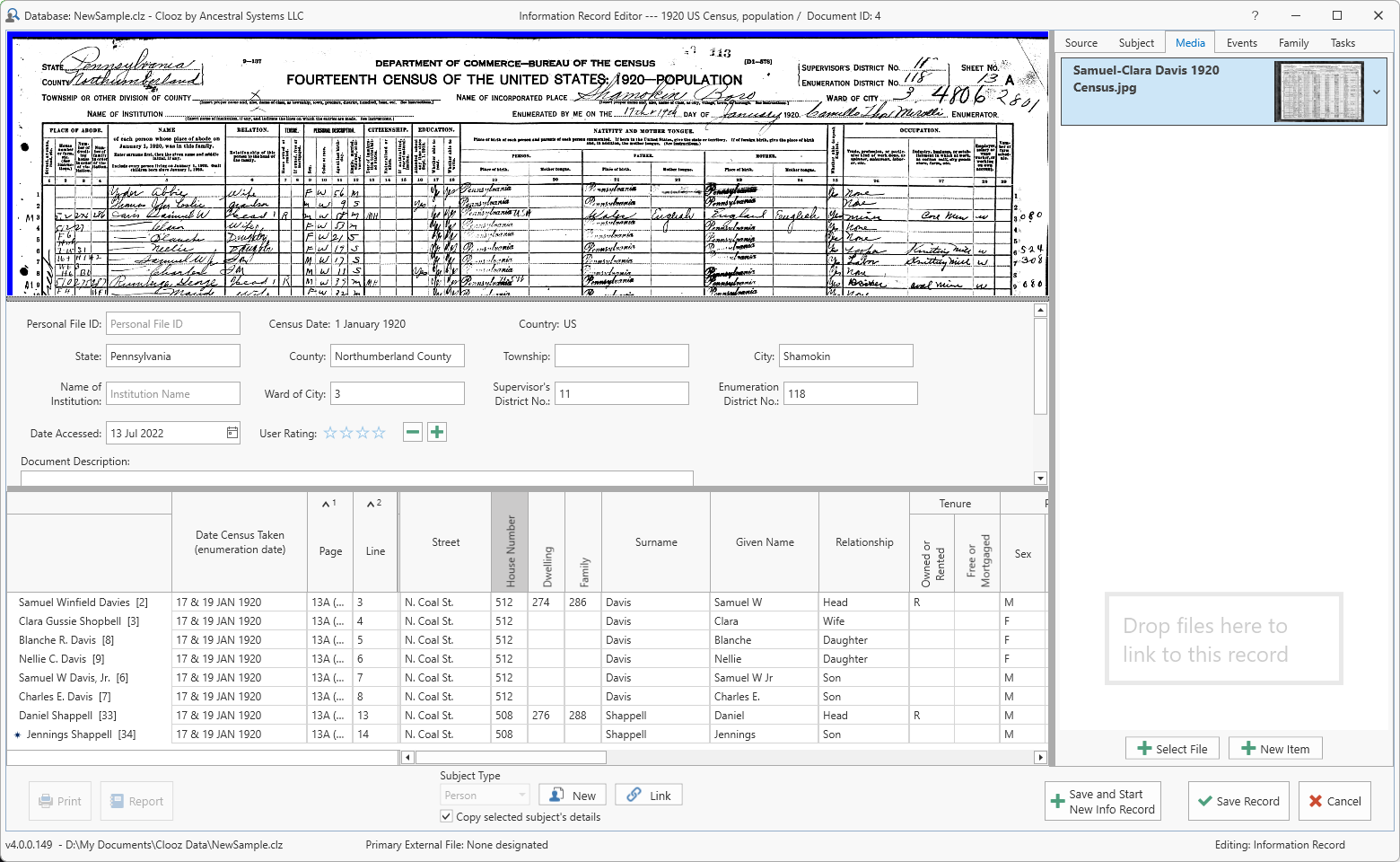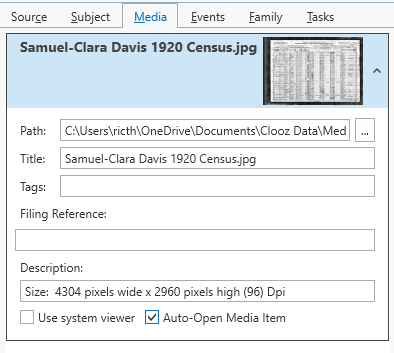Working with Digital Media Files
Clooz supports linking digital media files to the following types of records:
-
Repositories
 Where a source document or item was found. This could be a physical library facility or online data provider.
Where a source document or item was found. This could be a physical library facility or online data provider.
-
Sources
 A source record in Clooz should be viewed as the higher level components of a source citation. Citation details are pulled from the citing Information Record.
A source record in Clooz should be viewed as the higher level components of a source citation. Citation details are pulled from the citing Information Record.
-
Information Records
 Information Records in Clooz hold the content information coming from a document or other source. These differ from a Source record that contains most of the citation information describing the docment, or the Repository record referring to the facility or online service where the document was found.
Information Records in Clooz hold the content information coming from a document or other source. These differ from a Source record that contains most of the citation information describing the docment, or the Repository record referring to the facility or online service where the document was found.
To associate a digital media file with a Subject record![]() These are records in the Clooz database representing the Subjects being researched, and contain summary information about the Subject such as the birth, marriage, and death dates for people., create an Information Record of the appropriate type (Photograph, Audio, Video, etc) and link the Subjects
These are records in the Clooz database representing the Subjects being researched, and contain summary information about the Subject such as the birth, marriage, and death dates for people., create an Information Record of the appropriate type (Photograph, Audio, Video, etc) and link the Subjects![]() Subjects are the objects you are gathering information about. In most cases with Clooz, this is people. However, Clooz supports several other types of subjects such as businesses, real estate/buildings, ships and artifacts. associated with the file to that record.
Subjects are the objects you are gathering information about. In most cases with Clooz, this is people. However, Clooz supports several other types of subjects such as businesses, real estate/buildings, ships and artifacts. associated with the file to that record.
Clooz only saves the file location when linking a media file. The file itself is left external to the Clooz database.
Linking a media file to a Clooz record
 To link a media file, select the Media
To link a media file, select the Media![]() A digital file containing an image, text, spreadsheet, video, audio, or any other format. These can be attached to various records in Clooz as digital representations of source document content, or as Information Records (as photographs, maps, videos, or audio independent of a specific source document). tab in the editor's right side panel and do one of the following:
A digital file containing an image, text, spreadsheet, video, audio, or any other format. These can be attached to various records in Clooz as digital representations of source document content, or as Information Records (as photographs, maps, videos, or audio independent of a specific source document). tab in the editor's right side panel and do one of the following:
-
Drag and drop a file from the Windows file explorer or Clooz's own media file explorer onto the Media Panel in Clooz.
-
Click on the Select File button and then select a file from the file selection window that pops up. There are two types of file selection windows that can be used (default type is defined in the Clooz program options): A standard Windows-type file opening dialog form and a special Clooz media file explorer that identifies whether files are already linked to a Clooz record or not. Clicking the Select File button activates the default option. To activate the other type of selector, hold the Control or Shift key when clicking the button. See the Media File Explorer topic for a complete description of this tool.
-
Click the New Item button to add an unspecified media item, then open the new media item and enter in the file location.
Be sure to save the record you are linking the file to when closing it.
Editing the Media Item Details
 After linking media files to a Clooz record, you can enter more detailed information about them in the media item appearing on the media panel.
After linking media files to a Clooz record, you can enter more detailed information about them in the media item appearing on the media panel.
Click on the down arrow on the right side of the media item header (to the right of the thumbnail image). A box of detail fields will drop down for you to edit. Here you can edit the title, tags, filing reference and a description for the item.
When media items are first attached to Clooz, information in the detail properties fields of the Windows file are copied into the Clooz fields (Title, tags, description).
A filing reference field is provided if you want to keep track of the location of the original physical document or photograph within your filing system or photograph albums.
When media files are linked Clooz will automatically add details it finds in the Windows properties of that file.
Viewing Attached Media Files
Clooz provides you the option to view the contents of the attached media file in either Clooz's own media viewer, or in the viewer setup on your computer system as the Windows default. The Windows default viewer will be used if the Use system viewer box is checked on in the media item's details, or if you set your Clooz program options to not use the Clooz viewer.
The various media viewers in Clooz are all only for display (i.e., read-only). You cannot modify the original file, or save as a new file.
 Clooz's media viewer feature can display digital media files either inside the Clooz program window, or as a floating external window.
Clooz's media viewer feature can display digital media files either inside the Clooz program window, or as a floating external window.
There are 4 different viewer formats, supporting the commonly used file formats:
| Viewer Type | File Types |
|---|---|
| Image Viewer |
.bmp, .jpg, .jpeg, .gif, |
| Pdf File Viewer | |
| Text Viewer | .txt, .doc, .docx, .rtf |
| Spreadsheet Viewer | .xls, .xlsx |
Files of types other than those listed will automatically use the default viewer current set in Windows.
Display a file in the designated viewer (Clooz viewer or Windows default viewer) by doing one of the following:
-
 Right-click the desired media item in the media panel and select Display Selected Item,
Right-click the desired media item in the media panel and select Display Selected Item, -
 Open a media item in the media panel and check the box labeled Auto-Open Media Item. It will then appear automatically the next time the record is opened.
Open a media item in the media panel and check the box labeled Auto-Open Media Item. It will then appear automatically the next time the record is opened.
